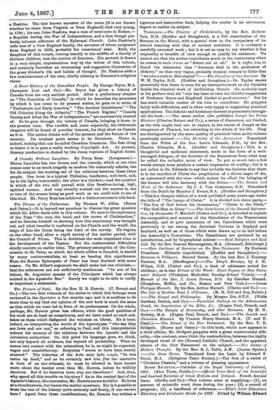The Picture of Paul. By the Rev. IL R. newels.
(C. Burnet and Co.)—The two first volumes of the series to which this belongs were reviewed in the Spectator a few months ago, and it is needless to do more than to say that our opinion of the new book is much the same as that which we were led to form of its predecessors. On the whole, perhaps, Mr. Haweis gives less offence, while the good qualities of his work are at least as conspicuous, and we have noted no such mitt. takes as those which disfigured the volumes on Christ. He is bent, indeed, on interpreting the words of the Apocalypse, "who my they are Jews and are not," as referring to Paul, and this interpretation colours his account of the relations between the Apostle and the Jerusalem authorities. On this point his language goes, we think, not only beyond all evidence, but beyond all probability. When he comes into contact with the miraculous, he is, as might be expected, vague and unsatisfactory. Entychus " seems to have been merely stunned." The historian of the Acts says 11pee reepds, "he was taken up dead," and as he certainly saw him (for the narrative is here of an eye-witness), he must be allowed to have known more about the matter even than Mr. Haweis, unless he wilfully deceives. But if he deceives here, why not elsewhere ? And, then, why spend all this trouble on his story ? As to the central fact of the Apostle's history, the convention, Mr. Ithweia seems doubtful. He hints at a thunderstorm, but leaves the matter uncertain. But is it possible to treat the rest of the history quite serionely and firmly, if one wavers here? Apart from these considerations, Mr. Haweis has written a
vigorous and instructive book, helping the reader in an uncommon degree to realise its subject.


































 Previous page
Previous page